Brazilian Marine Corps
| Brazilian Marine Corps Corpo de Fuzileiros Navais | |
|---|---|
 Brazilian Marine Corps seal. | |
| Founded | 1808 |
| Country |
|
| Type | Naval infantry |
| Size | 18,000 |
| Part of |
|
| General-Command HQ | Rio de Janeiro, Brazil |
| Motto(s) | Adsumus (English: Here we are) |
| Colors | Red and white |
| Anniversaries | March 7 |
| Commanders | |
| Commander-in-Chief | President Michel Temer |
| Commander of the Navy | Admiral Eduardo Leal Ferreira |
| General-Commander of the Marine Corps | Admiral Fernando Antonio de Siqueira Ribeiro |
| Insignia | |
| Flag |
 |
The Brazilian Marine Corps (CFN; Portuguese: Corpo de Fuzileiros Navais,[1] literally "corps of naval troopers") is the land combat branch of the Brazilian Navy.
Mission
Deployed nationwide, along the coast, in the riverine regions of Amazon and in the Pantanal, in peacetime it provides for the security of Naval installations and aids isolated populations through civic action programs in the Naval Districts. Abroad, it provides security for the Embassies of Brazil in Algeria, in Paraguay, in Haiti and in Bolivia. It has participated in all of the armed conflicts in the Military history of Brazil, foreign and domestic.
The badge consists of a fouled anchor superimposed over a pair of crossed rifles. It is worn on the collar points of the dress and service uniforms and on the Ribbon Bonnet (Gorro de Fita).
History
The Royal Brigade of the Navy
The Brazilian Marines trace their origin to 1808 when the troops of the Royal Brigade of the Navy (the Portuguese Marine Corps) arrived in Brazil (then a Portuguese colony) when Mary I of Portugal and her son Prince Regent John (later King John VI of Portugal) relocated themselves to the Portuguese South American territory during the Napoleonic Wars in Europe.
The baptism of fire: the conquest of Cayenne
In retaliation for the invasion of Portugal, Prince Regent, Dom João ordered the invasion of French Guiana, whose capital, Cayenne, was captured on the 14th of January 1809.
Historical campaigns
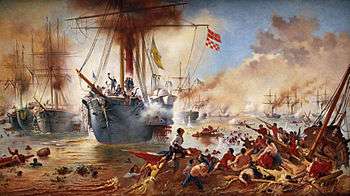
After Brazilian independence the force received many names and underwent various reorganisations. It was involved in several wars and campaigns: the War of the Independence of Brazil, conflicts in the River Plate basin, and the Paraguayan War. During the latter the Corps won distinction in both the Battle of Riachuelo and in the taking of Humaitá.
United Nations service
The CFN if has participated in the humanitarian actions promoted by UN in such diverse theatres of operation as Bosnia, Honduras, Mozambique, Rwanda, Angola, East Timor and currently in Haiti (MINUSTAH).
The Corps today

Staff and mission
With about 15,000 men, all volunteers, professionals in combat on land, air and sea, its mission is to guarantee the projection of the naval power on land, by means of landings from Navy ships and helicopters. The Corps is an integral part of the Navy, encompassing about one third of its manpower. Ranks are naval instead of Army, with the exception of Privates, who are called Soldados (Soldiers).
In the case of Brazil this is a complex mission, since the country has a territory of about 8,5 million km² (3.28 million sq. miles), a coast of more than 7,400 km (4,600 mi) with many oceanic islands, and a navigable waterways network of approximately 50,000 km (31,000 mi). This last one includes the Brazilian Amazon. To cover climates and natural landscapes so diversified as Pampas of Rio Grande Do Sul, pantanal of Mato Grosso do Sul, deserts of the Northeast region and Amazonian Rainforest, demands a training of the highest standards, agility and versatility. Therefore, there are units trained in demolition techniques, special operations, combat in forests, mountain and ice, and helicopter-transported operations.
Trained as a Fast Deployment Unit, recently, with the sending of Brazilian military observers, also integrating the Peacekeeping Forces of the United Nations, the Marines have made their presence in distinctive areas of conflict as El Salvador, Bosnia, Angola, Moçambique, Ruanda, Peru, Ecuador, East Timor and currently Haiti.
On March 30, 2014 security forces in Rio de Janeiro occupied since the dawn of day, the set of Shantytown Tide in the North Zone of Rio. Region is being prepared to receive the Pacifying Police Unit (UPP), Brazilian Marine Corps also provide support with 21 armored vehicles and 500 men.
Organization
The Corps headquarters is located in Fortaleza de São José, Ilha das Cobras, Rio de Janeiro.

Fleet Marine Force
The Fleet Marine Force (Força de Fuzileiros da Esquadra (FFE)) consists of the following units:
- 1st Amphibious Division (Divisão Anfíbia (DivAnf)) of brigade size with three marine infantry battalions (Batalhão de Fuzileiros Navais (BFN) as its main fighting force, along with the following:
- Command and Control Battalion (Batalhão de Comando e Controle),
- 1st "Riachuelo" Marine Infantry Battalion (BFN)
- 2nd "Humaita" Marine Infantry Battalion (BFN)
- 3rd "Paissandu" Marine Infantry Battalion (BFN)
- Marine Artillery Battalion (Batalhão de Artilharia de Fuzileiros Navais)
- Marine Armoured Vehicle Battalion (Batalhão de Blindados)
- Marine Tactical Air Control and Air Defence Battalion (Batalhão de Controle Aerotático e Defesa Antiaérea)
- Governor's Island Marine Base (Base de Fuzileiros Navais da Ilha do Governador),
- Reinforcement Troop (Tropa de Reforço (TrRef)) located in Ilha das Flores in São Gonçalo (RJ), composed of the following:
- Marine Engineer Battalion (Batalhão de Engenharia de Fuzileiros Navais),
- Marine Logistic Battalion (Batalhão Logístico de Fuzileiros Navais),
- Amphibious Vehicles Battalion (Batalhão de Viaturas Anfíbias),
- Police Company (Companhia de Polícia)
- Landing Support Company (Apoio ao Desembarque)
- Isle of Flowers Marine Base (Base de Fuzileiros Navais da Ilha das Flores),
- Landing Troop Command (Comando da Tropa de Desembarque (ComTrDbq)), located at Duque de Caxias (RJ) - provides the means to command, control and administer the Command of the Fleet Marine Force and to also local units
- Marine Special Operations Battalion "Tonelero" (Batalhão de Operações Especiais de Fuzileiros Navais (Batalhão Tonelero)) A unit similar to US Marine Corps Force Reconnaissance, formed in 1957 and structured for high risk operations. Its mission is to destroy or damage prominent objectives in heavily defended areas, capture or rescue personnels or equipment, seize installations, obtain information, mislead and produce psychological effects.
- Rio Meriti Naval Marine Base (Base de Fuzileiros Navais do Rio Meriti (BFNRM)), located in Duque de Caxias (RJ)
- ships detachments
Regional
"Marine Groups" (Grupamentos de Fuzileiros Navais (GptFN) are subordinate to the Naval Districts (Distritos Navais), for the security of naval installations, as well as performing operations in support of the Naval District where they are assigned, while the 7th Marine Group is also tasked for public duties in the Brasilia area. They are located in the vicinity of the local Naval District headquarters. The 8th Naval District does not possess any such group. GptFNs are small-sized Marine battalions.
- GptFN of Rio de Janeiro, RJ (1st DN)
- GptFN of Salvador, Bahia (2nd DN)
- GptFN of Natal, Rio Grande do Norte (3rd DN)
- GptFN of Belém, Pará (4th DN)
- GptFN of Rio Grande, Rio Grande do Sul (5th DN)
- GptFN of Ladário, Mato Grosso do Sul (6th DN)
- GptFN of Brasília, Distrito Federal (7th DN)
- Riverine Operations Battalion (Batalhão de Operações Ribeirinhas), Manaus, Amazonia (9th DN)
Musical support is rendered by the Central Band of the Marine Corps in Rio (1st ND), the Brasilia Marine Corps Band and the Marine Drum and Bugle Corps (7th Naval District) and by the Marine Bands of each of the other Naval Districts save for the 8th ND.
Methods
To fulfill its missions, the Marines land off the ships of the Brazilian Navy, be it using landing boats, amphibious vehicles or helicopters. For this they count on the support of the navy and/or sea and air support.
On land, it operates its normal way, which include tanks, field artillery, antiaircraft artillery, combat engineering, communications and electronic warfare.
Training
To fulfill its missions, fusiliers must pass a rigorous physical training program, normally with many runs, calisthenics, sleep deprivation, swimming while holding their breath, practice shooting with diverse armaments, especially metal rings, rappeling and, in some cases, combat.
Uniforms
The Brazilian Marines wear the variation of the Brazilian Lizard Pattern, known as navy lizard . Vest's: The marines for a long time used the IBA "Interceptor body armor" in woodland, but they are now being replaced by Eagle industries Maritime Ciras with Woodland Cover, and Black for SOF. For the Comandos Anfibios is also issued a green version and black version of the WTC Recon Plate Carrier. Boot: They use Atlas Atalaia combat boots, in coffee brown.
Gallery
-

Pardo and preto Brazilian marines pose for a photographer on board the Brazilian battleship Minas Geraes, likely taken during the ship's visit to the United States in early 1913.
-
.jpg)
Brazilian marines protection in response to chemical emergencies
-

Brazilian Marines in the red gala uniform titled "Garança"
-
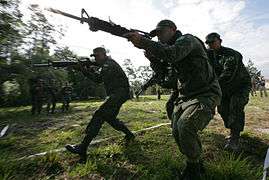
Brazilian marines demonstrate lane training
-
.jpg)
Marines corps in riverine operations.
-
.jpg)
Brazilian AAV amphibious vehicle in action
-
.jpg)
Landing ship dock amphibious vehicles.
-
.jpg)
Rocket artillery in Brazilian Marines Corps
-
.jpg)
Marines on patrol boat for river
-

Brazilian naval infantry
-

Brazilian Marines in landing exercise
-
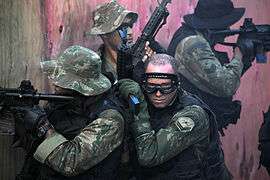
Members of the Brazilian Marine Corps Special Operations Battalion
-
.jpg)
Members of the Brazilian Marine Corps
-

Two members of the command amphibious operations
-

Marines in operation of law and order in Rio de Janeiro
Main Equipment
Tank
| Equipment | Origin | Type | Versions | In service | Notes | Photo |
|---|---|---|---|---|---|---|
| SK-105 Kürassier | |
Light tank | SK 105A2S 4KH7FA |
16 01 |
Planned more 22 vehicles for the future. | .jpg) |
Infantry fighting vehicles
| Equipment | Origin | Type | Versions | In service | Notes | Photo |
|---|---|---|---|---|---|---|
| M113 | |
Armored personnel carrier | M113A1 M125A1 M577A1 XM806E1 M113A1G |
24 02 02 01 01 |
Upgrade to finish in 2013. Planned more 42 vehicles for the future. | .jpg) |
| Mowag Piranha 8x8 | |
Armoured personnel carrier/reconnaissance | Piranha IIIC | 30 | Delivery Process. Planned more 42 vehicles for the future (or the new Guarani). | .jpg) |
| AAV-7A1 | |
Armoured personnel carrier/Assault Amphibious | AAV-7A1 LVTP-7A1 LVTC-7A1 LVTR-7A1 |
39 09 02 02 |
Brazil plans to buy 26 additional AAV-7 assault amphibious vehicles, and to upgrade those it currently operates to the same RAM/RS standard. Planned more 78 vehicles for the future. | .jpg) |
| AV-VBL 4x4 | |
Light Armored Vehicle | 03 | Vehicle auxiliary support groups artillery rocket. | .jpg) |
Artillery
| Equipment | Origin | Type | Versions | In service< | Notes | Photo |
|---|---|---|---|---|---|---|
| Astros II | |
Multiple Launch Rocket System | ASTROS FN | 06 | One battery being ordered. Two more in the future (one complete group: tree batteries). | .jpg) |
| M114 | |
Howitzer | M114A1 | 06 | 155mm. Study in progress for replacement by M777 howitzer. |  |
| L118 light gun | |
Howitzer | L118 | 18 | 105mm. Planned to acquire 30 more. |  |
| Soltam K6 | |
Mortar | K-6A3 | 06 | 120mm | .jpg) |
| M29 mortar | |
Mortar | M29 A1 | 100 | 81mm | 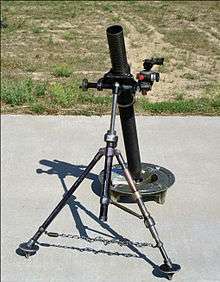 |
| Brandt | |
Mortar | Brandt | ? | 60mm | |
| Bofors L70 | |
Autocannon AA | Bofors 40 mm | 06 | 40mm. Using the radar Bandvagn 206 | .jpg) |
Anti-aircraft missiles
| Equipment | Origin | Type | Versions | In service | Notes | Photo |
|---|---|---|---|---|---|---|
| Mistral | |
MBDA missile systems | Surface-to-air missile | 24 systems | Using the radar Bandvagn 206 | .jpg) |
| RBS 70 | |
MBDA missile systems | Surface-to-air missile | 12 systems |  | |
| Pantsir-S1 | Surface-to-air missile | 0 | future acquisition in developing of 1 battery. | 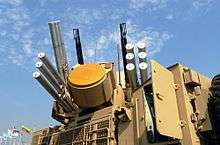 |
Radar
| Equipment | Origin | Type | Versions | In service | Notes | Photo |
|---|---|---|---|---|---|---|
| Saber Radar | |
Saber M60 | Air defense radar | 01 | .jpg) | |
| Bandvagn 206 | |
B206 | Radar | 01 | Using the MBDA missile systems | |
Unmanned aerial vehicle
| Equipment | Origin | Type | Versions | In service | Notes | Photo |
|---|---|---|---|---|---|---|
| Carcara UAV | |
UAV | 40 |  | ||
| Carcara II | |
UAV | 02 | |||
| Horus FT-100 | |
UAV | 01 |  |
Vehicles
| Name | Type | Quantity | Origin | Notes | Photo |
|---|---|---|---|---|---|
| Agrale Marruá | Light Utility Vehicle | 450 | |  | |
| Land Rover Defender | Light Utility Vehicle | 257 | | .jpg) | |
| Land Rover Discovery | Administrative Vehicle | 60 | | ||
| Toyota Bandeirante | Light Utility Vehicle | 270 | | .jpg) | |
| Unimog4x4 and 6x6 | Truck | 248 | | ||
| MBB 1720 4x4 | Truck | 200 | | .jpg) | |
| MBB 1725/42 4x4 | Truck | 122 | |  | |
| MBB LAK1418 4x4 | Truck | ? | | ||
| M35 Reo 6x6 | Medium Truck | 56 | |  | |
| Volvo NL | Truck | ? | |
Motorcycle
| Name | Type | Quantity | Origin | Notes | Photo |
|---|---|---|---|---|---|
| Harley-Davidson Road King Police | Escort Motorcycle | ? | | used by Battalion of Naval Police | .jpg) |
Individual weapons and equipment
Pistols
| Origin | Model | Caliber | Type | Image |
|---|---|---|---|---|
| |
Glock 17 | 9×19mm (Used by SOF) | Pistol | 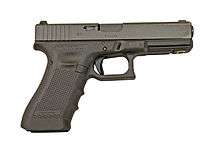 |
| |
Taurus PT-92 | 9×19mm (Standard issue) | Pistol | |
Submachine guns
| Origin | Model | Caliber | Type | Image |
|---|---|---|---|---|
| |
Beretta M12 | 9×19mm (Standard isse) (Known as MT-12) | Submachine gun |  |
| |
MP5 | 9×19mm (Used by SOF) | Submachine gun | 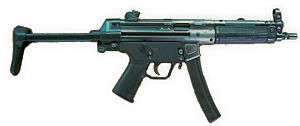 |
| |
Mini-Uzi | 9×19mm (Used by SOF) | Submachine gun | 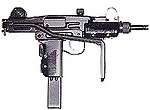 |
Rifles
| Origin | Model | Caliber | Type | Image |
|---|---|---|---|---|
| |
M16A2 | 5.56×45mm | Assault rifle | |
| |
M4 | 5.56×45mm | Carbine |  |
| |
Parker Hale M85 | .308 sniper rifle | sniper rifle |  |
| |
PGM Hécate II | 12.7×99mm | sniper rifle |  |
Machine guns
| Origin | Model | Caliber | Type | Image |
|---|---|---|---|---|
| |
M2 Browning machine gun | 12.7×99mm | Heavy machine gun |  |
| |
FN MAG M971 | 7.62×51mm | Medium machine gun |  |
| |
FN Minimi | 5.56×45mm | Light machine gun | .jpg) |
Grenade launchers
| Origin | Model | Caliber | Type | Image |
|---|---|---|---|---|
| |
Mk19 | 40 mm | Grenade launcher |  |
| |
M203 grenade launcher | 40×46mm | Grenade launcher |  |
Anti-armor
| Origin | Model | Caliber | Type | Image |
|---|---|---|---|---|
| |
AT4 | 84mm (To be replaced by the national ALAC) | Anti-tank weapon | |
| |
ALAC (Arma Leve Anticarro) | 84mm (Going into mass production in 2012. Replacing the AT4) | Anti-tank weapon | |
| |
BILL | 130mm | Anti-tank missile | |
| |
MSS-1.2 | 130mm | Anti-tank missile |
Historical equipment
| Equipment | Origin | Employee year | QTD | Notes | Picture |
|---|---|---|---|---|---|
| EE-9 Cascavel | |
1979-2000 | 06 | Armoured car |  |
| EE-11 Urutu | |
1976-2000 | 05 | Armored personnel carrier | |
| EE-34 | |
1970-1996 | 50 | Pickup | 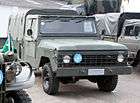 |
| EE-14 | |
1970-1999 | ? | Truck | |
| DUKW | |
1970-1987 | 34 | Amphibious transport | 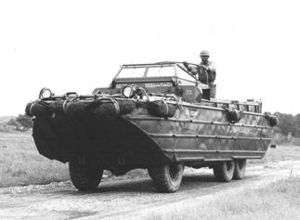 |
| Ford GPA | |
1950-1985 | ? | Amphibious transport |  |
| Mosquefal | |
1968-2000 | ? | Rifle | |
| FN FAL | |
1970-2000 | ? | Battle rifle | |
| Browning BAR | |
1945-1970 | ? | Battle rifle | |
| Madsen machine gun | |
1946-1980 | ? | Light machine gun |  |
| INA Model 953 | |
1950-1990 | ? | Sub machine gun | |
| Mekanika Uru | |
1970-1990 | ? | Sub machine gun | |
See also
References
- ↑ Trevor Nevitt Dupuy (1993). International military and defense encyclopedia, Volume 1. Brassey's (US). p. 137.
External links
| Wikimedia Commons has media related to Corps of Naval Fusiliers. |
- Official website (in Portuguese only)
- Fleet Marine Force website (in Portuguese only)